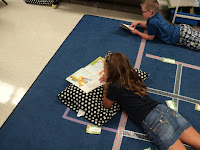Habits....
I'm trying to create some habits. I have some apps (Productive, Rally, Fit Bit) to help me with those habits. I have to say....the eating fruit habit is not going so well! So why do I think habits will work in a classroom?Research says that it can take up to 8 months to create a habit! Yikes! We only teach 180 days a year! So how can we create automaticity (habits) in our students? It might help that they are a
A blog,http://sourcesofinsight.com/50-repetitions-to-make-a-habit-stick/ talks about repetition and habits.
Also, when thinking about creating these fundamental habits in a classroom, it will get much easier, and virtually unneccesary in upper grades, if all teachers follow these same routines and procedures.
 |
| Once again, primary teachers SAVE THE DAY!! |
Chapter 1 in Great Habits, Great Readers focuses on the procedures and creating of habits in your classroom. (The READERS part of the title needs to be ignored for now. This will work in ANY classroom, all day long!)
Why do you want to establish procedures?
It will save time...and I don't mean minutes. It can save DAYS, y'all. Think back to your transitions - from carpet to desks, desks to carpet, station to station, desks to door, etc. Tick...tick...tick...tick..Core ideaYou can't add more hours to the week, but you can add more hours of INSTRUCTION . Just build tighter routines.
Give high priority to efficiency in the systems that happen most frequently over the course of the school day.
Core idea
Time lost to systems is time lost for learning.
Some of these time eaters are on the teacher: Are materials ready and at your teaching spot? Do you have activities ready for children, learning and practice they can do on the carpet as they are all getting to their spots?
(If I am your coach, I would be more than happy to come and time your transitions for you! It seems like it would be really difficult to do on your own!)
Some of these time eaters are on the kids: "That's my spot!" "I can't find my crayons, pencil, eraser...."
You can hear them now.
You can see them now.
Quick, back to summer!!!
While you are working on that new recipe (for whatever summer delight you are concocting) think about making thoughtful and intentional transitions, to make transformational instruction possible.
The book tells about two ways to make the greatest gains in student learning.
1. Setting up the room.
Core idea
The best classrooms don't just encourage student learning; they're designed for it.
Set up space and resources to intentionally maximize time whenever possible.*It took me a few years, but I hated dismissal time. It ate a LOT of time. I put half of the mailboxes on one side of the room, and half on the other side. So at dismissal, instead of having 24 kids trying to get to their mail at once, I had 12. Easy, peasy!
Have resources at your small group table. Make sure students know that learning is occurring at all times.
Great Habits, Great Readers lists the top seven materials to have on hand.
Core Idea:
Pay attention to materials before the lesson....so you can ignore them during it.
 |
| I have these pictures because I took pictures as we learned procedures, printed them out the first day of school, then made procedural anchor charts which were used all year. |
*Also, in kindergarten, I taped shapes to the floor (triangles, rectangles, etc), and had shapes on the tables. Triangles would line up, etc. Needed math vocabulary AND procedures!!
*In first and 2nd grade I had students line up in ABC order by 1st name. (This would change every week, because my helpers changed weekly. That kept them on their toes!) Every 6 weeks I would rotate...last name, first name, etc. Until the last 6 weeks of school...then we lined up by MIDDLE name! The excitement!!
*I assigned carpet spots....yes I did.
I taped their names on the carpet, using name plates. Let me just say...the counselor, principal, visitors to our classroom loved that. And now that I am going in and teaching lessons to 80-100 different children a day...I would love that, too! It's a really great way for visitors to call kids by name.
 |
| You can kind of see the sight word cards taped to the carpet. |
I also had sight words on yarn necklaces, and sight words taped to the carpet. When the students came in to the classroom, I would greet them, they would sign in (attendance/lunch count), grab a necklace, and that was their spot on the carpet for the day. They would read the word to their neighbor, it was their job to write that work in interactive writing, find they word and highlight it in shared reading, etc. I didn't start this until I had enough sight words for each child...usually the fourth week of school.
You could also use the carpets with letters (first or last name, vowels/consonants, etc.).
And if your carpet doesn't have squares already....duck tape, y'all!
2. Habits of effective transitions.
Core idea
To make great transition work, you must first take the time to practice them.
Tightly scripted....every single transition....every single time...with a positive tone (and a little hint of challenge!)The videos that are included with the book are amazingly insightful!
Also...gradual release: I do (10%); We do (60%), You do (30%)
Key tips in effective transitions (as quoted in the book):
- Teacher location
- Instructional materials
- Designated pathways
- Economy of language (none is best)
- Immediate start
- Chanting (optional...but fun!)
Core Idea
Repeatedly teach your students to be the class you want. Excellence is not an act but a habit.
So go, relax, dream of your perfect class.
Now...what changes do YOU need to make to make that dream a reality?








